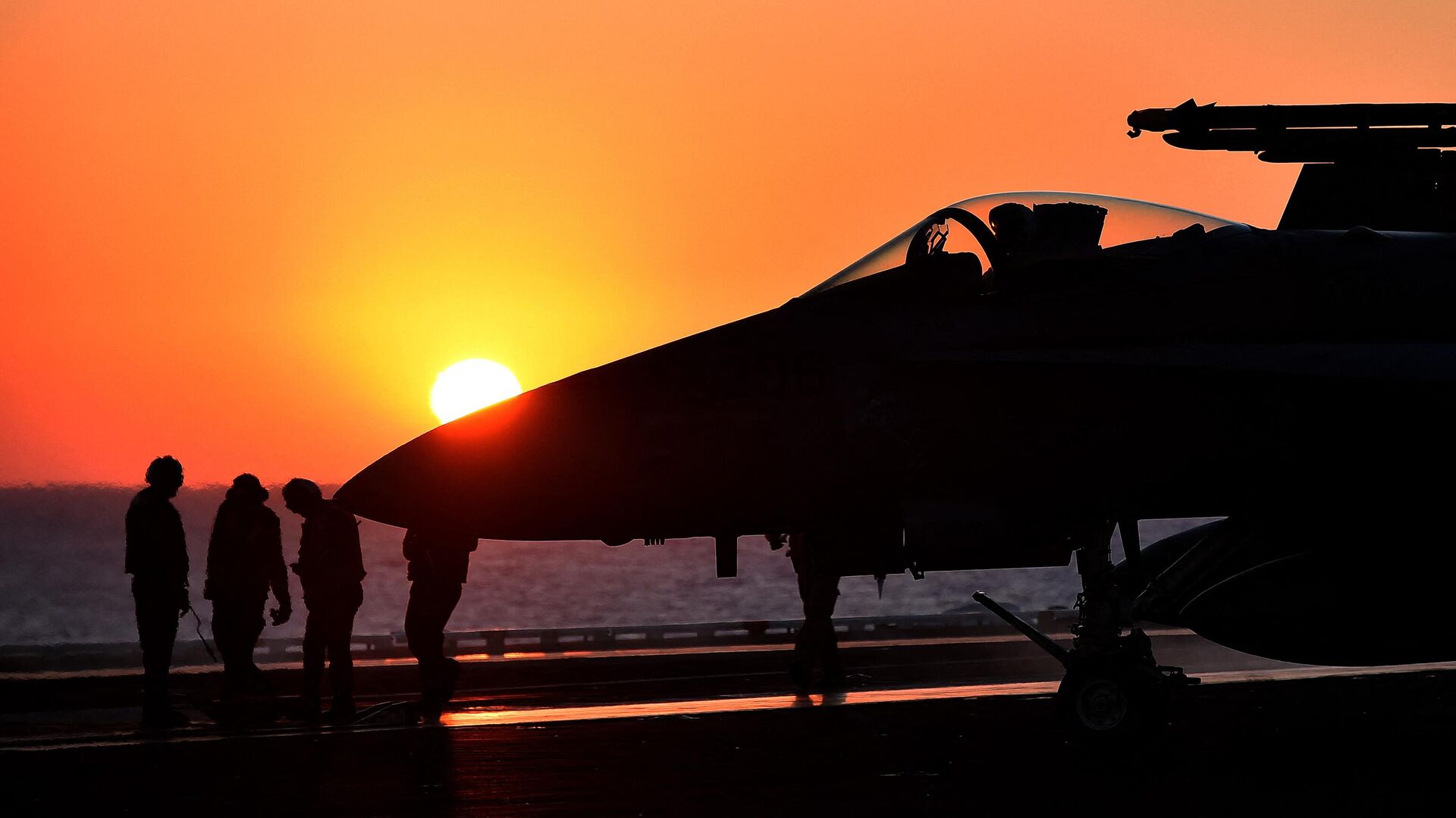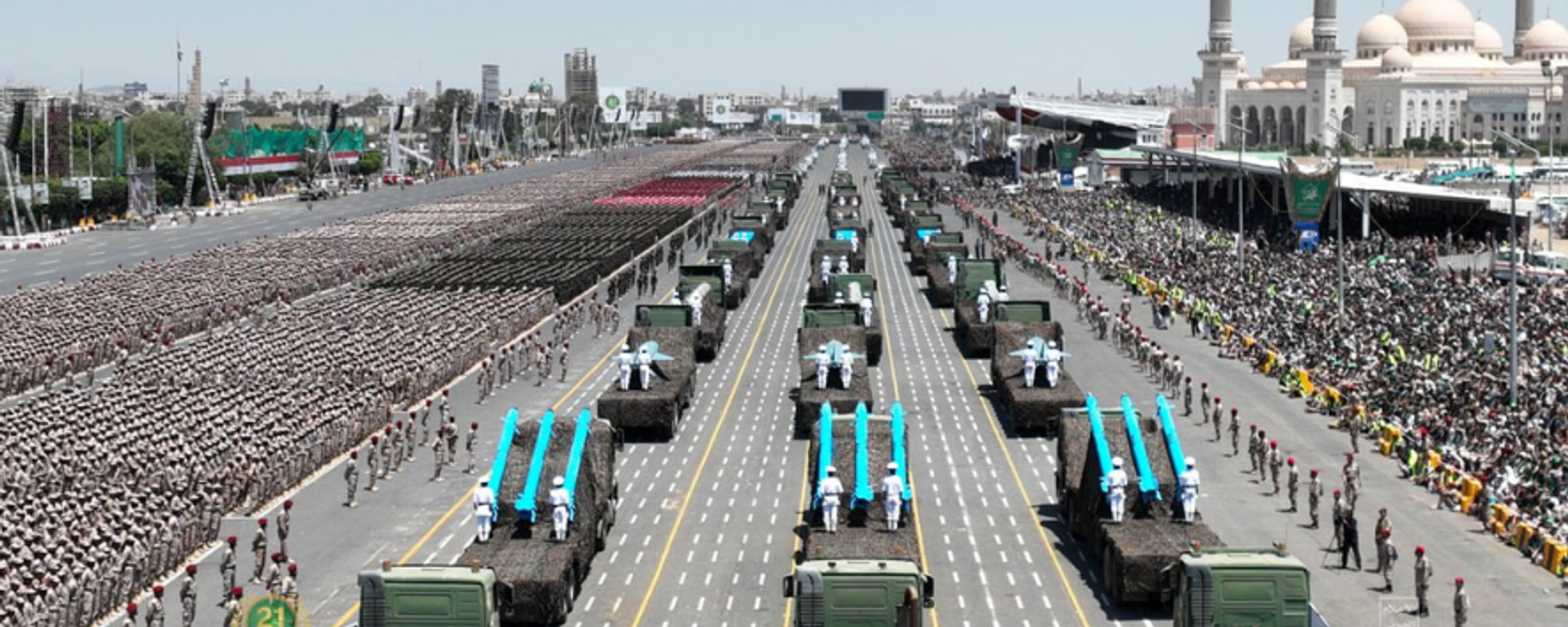https://sputnikglobe.com/20240525/us-expends-530-munitions-1-bln-fighting-houthi-hellfire-raining-down-on-its-carrier-group-1118634310.html
US Expends 530 Munitions, Over $1 Bln Fighting Houthi Hellfire Raining Down on Its Carrier Group
US Expends 530 Munitions, Over $1 Bln Fighting Houthi Hellfire Raining Down on Its Carrier Group
Sputnik International
The US and Britain hastily assembled a coalition of the willing in December 2023 to target the Houthis, a month after the indefatigable Yemeni militia began a campaign of ship seizures, drone and missile attacks targeting Israeli-linked merchant vessels in the Red Sea, in solidarity with Gaza.
2024-05-25T15:17+0000
2024-05-25T15:17+0000
2024-05-25T15:17+0000
world
red sea
yemen
israel
dwight d. eisenhower
military & intelligence
houthis
houthi
navy
tomahawk
https://cdn1.img.sputnikglobe.com/img/07e8/05/19/1118634638_0:159:3077:1889_1920x0_80_0_0_4259c2038ffc232bcc2ba8985fda8221.jpg
The Dwight D. Eisenhower supercarrier-led US Navy strike group has expended over 500 munitions targeting Houthi-launched missiles, UAVs and drone boats over and in the Red Sea, and positions inside Yemen, a new tally of Navy data has revealed.The figures, seen by Business Insider, reportedly included almost 430 instances of US warships and aircraft engaging “planned and dynamic Houthi targets,” with the Eisenhower’s onboard F/A-18 Super Hornet strike jets flying over 27,200 hours across roughly 12,100 sorties, launching 350+ air-to-surface missiles and 50+ air-to-air missiles.Guided-missile destroyers and cruisers accompanying the Eisenhower have reportedly launched 100 Standard Missile-2 interceptors and Tomahawk cruise missiles at Houthi aerial and ground targets.The figures offer the most detailed insight to date into the expenses the US-led anti-Houthi mission in the Red Sea has sustained to date.Last month, Navy Secretary Carlos Del Toro told lawmakers from the Senate Appropriations Committee that the US had spent nearly $1 billion in the Middle East, including against the Houthis, since the Israeli-Hamas escalation in October, and asked for more money.But the Navy figures cited by Business Insider suggest the costs could be much higher. For example, F/A-18 jets have an average per hour flight cost of more than $30,400, meaning if the Navy-provided data are correct, the US has spent close to $827 million on sorties alone, not counting expended missiles. The latter include AIM-7 Sparrow and AIM-9 Sidewinder air-to-air missiles, priced between $125,000 and $400,000 apiece, and AGM-88 HARM air-to-surface missiles, which go for between $284,000 and $870,000 each.Ship-launched standard Missile-2 interceptors cost $2 million apiece, with the more advanced Standard Missile-6 – which the US carrier strike group has also deployed against the Houthis, costing $4.3 million each. Tomahawk land attack cruise missiles, meanwhile, have a price tag of roughly $2 million.The Pentagon’s anti-Houthi strategy has recently taken flak from US lawmakers over its exorbitant cost.US-led military operations in the Red Sea, dubbed Operation Prosperity Guardian, have failed to stop or even scale back the extent of Houthi attacks, with the militia ramping up its strikes in the Red and Arabian Seas in recent months, and expanding drone and missile forays into the Indian Ocean and the Mediterranean Sea.The Carney returned home to Naval Station Mayport in Jacksonville, Florida on May 19 after its long Red Sea deployment.Separately on Friday, the Houthis announced that they had targeted three more Israeli-linked ships, including the MSC Alexandra and the Greek-owned Yannis bulk carrier (which the militia said was heading toward Israel) in the Red Sea, and the Essex LPG carrier – a Liberia-registered vessel managed by Zodiac Maritime, owned by Israeli tycoon Eyal Ofer, in the Mediterranean.The Mediterranean attack came just a few days after an anonymous Pentagon official confirmed to reporters that the Houthis have weapons that could reach the body of water – situated over 2,000 km from militia-held areas of Yemen.Along with their attacks on ships, the Houthis have been stepping up their efforts to target US military assets operating over Yemeni airspace. Last week, the group downed its fifth MQ-9 Reaper drone using a “locally-made” surface to air missile while the $32 million aircraft was “carrying out hostile acts” over Marib province in western Yemen.
https://sputnikglobe.com/20240522/us-admits-houthis-can-hit-ships-in-mediterranean-as-militia-swats-down-another-reaper-1118590306.html
https://sputnikglobe.com/20240515/houthis-have-defeated-american-goliath---uk-media-1118452721.html
red sea
yemen
israel
Sputnik International
feedback@sputniknews.com
+74956456601
MIA „Rossiya Segodnya“
2024
News
en_EN
Sputnik International
feedback@sputniknews.com
+74956456601
MIA „Rossiya Segodnya“
Sputnik International
feedback@sputniknews.com
+74956456601
MIA „Rossiya Segodnya“
why can't the houthis be beat, why are the houthis attacking ships
why can't the houthis be beat, why are the houthis attacking ships
US Expends 530 Munitions, Over $1 Bln Fighting Houthi Hellfire Raining Down on Its Carrier Group
The US and Britain hastily assembled a coalition of the willing in December 2023 to target the Houthis, a month after the indefatigable Yemeni militia began a campaign of ship seizures, drone and missile attacks targeting Israeli-linked merchant vessels in the Red Sea, in solidarity with Gaza.
The Dwight D. Eisenhower supercarrier-led US Navy strike group has expended over 500 munitions targeting Houthi-launched missiles, UAVs and drone boats over and in the Red Sea, and positions inside Yemen, a new tally of Navy data has revealed.
The
figures, seen by Business Insider, reportedly included almost 430 instances of US warships and aircraft engaging “planned and dynamic Houthi targets,” with the Eisenhower’s onboard F/A-18 Super Hornet strike jets flying over
27,200 hours across roughly
12,100 sorties, launching
350+ air-to-surface missiles and 50+ air-to-air missiles.Guided-missile destroyers and cruisers accompanying the Eisenhower have reportedly launched 100 Standard Missile-2 interceptors and Tomahawk cruise missiles at Houthi aerial and ground targets.
The figures offer the most detailed insight to date into the expenses the US-led anti-Houthi mission in the Red Sea has sustained to date.
Last month, Navy Secretary Carlos Del Toro told lawmakers from the Senate Appropriations Committee that the US had spent
nearly $1 billion in the Middle East, including against the Houthis, since the Israeli-Hamas escalation in October, and asked for more money.
But the Navy figures cited by Business Insider suggest the costs could be much higher. For example, F/A-18 jets have an average per hour flight cost of more than $30,400, meaning if the Navy-provided data are correct, the US has spent close to $827 million on sorties alone, not counting expended missiles. The latter include AIM-7 Sparrow and AIM-9 Sidewinder air-to-air missiles, priced between $125,000 and $400,000 apiece, and AGM-88 HARM air-to-surface missiles, which go for between $284,000 and $870,000 each.
Ship-launched standard Missile-2 interceptors cost
$2 million apiece, with the more advanced Standard Missile-6 – which the US carrier strike group has also deployed against the Houthis, costing
$4.3 million each. Tomahawk land attack cruise missiles, meanwhile, have a price tag of roughly
$2 million.
The Pentagon’s anti-Houthi strategy has recently taken flak from US lawmakers over its exorbitant cost.
“In the Red Sea, the Houthis are sending $20,000 drones and we’re shooting them down with missiles that cost $4.3 million. The math doesn’t work on that, gentlemen. It just doesn’t work. What are we thinking?” Senate Armed Services Subcommittee on Strategic Forces chairman Angus King
said earlier this month during a grilling of senior DoD officials on the (apparently) shambolic state of America’s air and missile defense capabilities.
US-led military operations in the Red Sea, dubbed Operation Prosperity Guardian, have failed to stop or even scale back the extent of Houthi attacks, with the militia ramping up its strikes in the Red and Arabian Seas in recent months, and expanding drone and missile forays into the Indian Ocean and the Mediterranean Sea.
Pentagon chief Lloyd Austin hinted at the intensity of Houthi operations on Friday, revealing that the USS Carney guided-missile destroyer alone had had 51 “engagements” with Houthi missiles and drones over six months, “which is the most direct Navy engagement with a foe since World War II.”
The Carney returned home to Naval Station Mayport in Jacksonville, Florida on May 19 after its long Red Sea deployment.
Separately on Friday, the Houthis
announced that they had targeted three more Israeli-linked ships, including the MSC Alexandra and the Greek-owned Yannis bulk carrier (which the militia said was heading toward Israel) in the Red Sea, and the Essex LPG carrier – a Liberia-registered vessel managed by Zodiac Maritime, owned by Israeli tycoon Eyal Ofer, in the Mediterranean.
The Mediterranean attack came just a few days after an anonymous Pentagon official
confirmed to reporters that the Houthis have weapons that could reach the body of water – situated over 2,000 km from militia-held areas of Yemen.
Along with their attacks on ships, the Houthis have been stepping up their efforts to target US military assets operating over Yemeni airspace. Last week, the group downed its fifth MQ-9 Reaper drone using a “locally-made” surface to air missile while the $32 million aircraft was “carrying out hostile acts” over Marib province in western Yemen.






